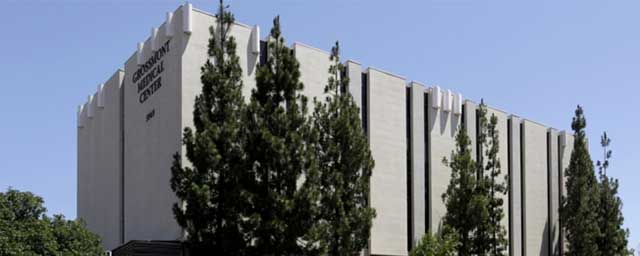During knee replacement surgery, damaged bone and cartilage is resurfaced with metal and plastic components. In unicompartmental knee replacement (also called “partial” knee replacement) only a portion of the knee is resurfaced. This procedure is an alternative to total knee replacement for patients whose disease is limited to just one area of the knee.
Because a partial knee replacement is done through a smaller incision, patients usually spend less time in the hospital and return to normal activities sooner than total knee replacement patients.
There are a range of treatments for knee osteoarthritis and Dr. Allsing will discuss with you the options that will best relieve your individual osteoarthritis symptoms.
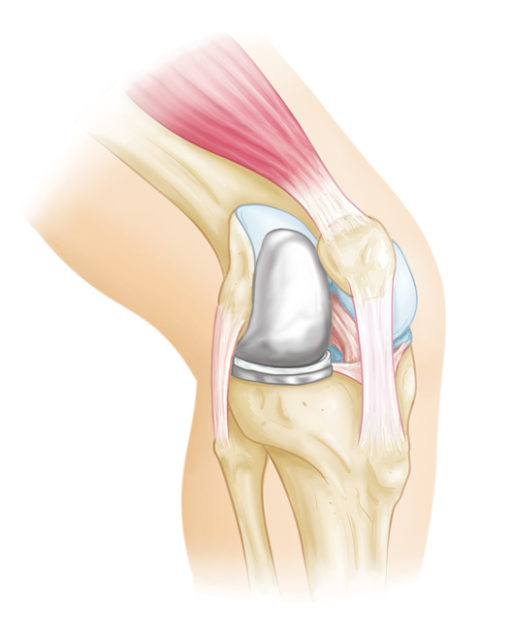
In unicompartmental knee replacement, only one area of the knee is resurfaced.
Description
In knee osteoarthritis, the cartilage protecting the bones of the knee slowly wears away. This can occur throughout the knee joint or just in a single area of the knee.
Your knee is divided into three major compartments:
- Medial compartment (the inside part of the knee)
- Lateral compartment (the outside part)
- Patellofemoral compartment (the front of the knee between the kneecap and thighbone)
Advanced osteoarthritis that is limited to a single compartment may be treated with a unicompartmental knee replacement. During this procedure, the damaged compartment is replaced with metal and plastic. The healthy cartilage and bone, as well as all of the ligaments are preserved.
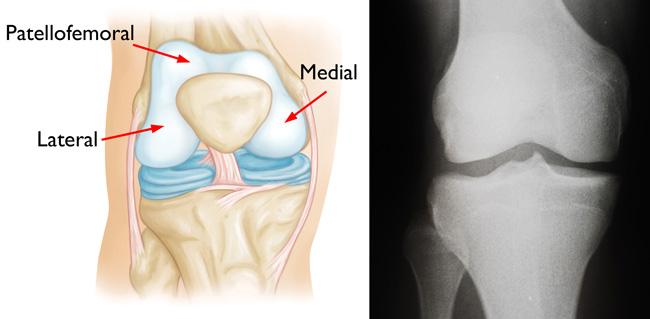
(Left) A normal knee joint: The medial, lateral, and patellofemoral compartments are shown with red arrows. (Right) An x-ray of a normal knee joint showing healthy space between the bones.
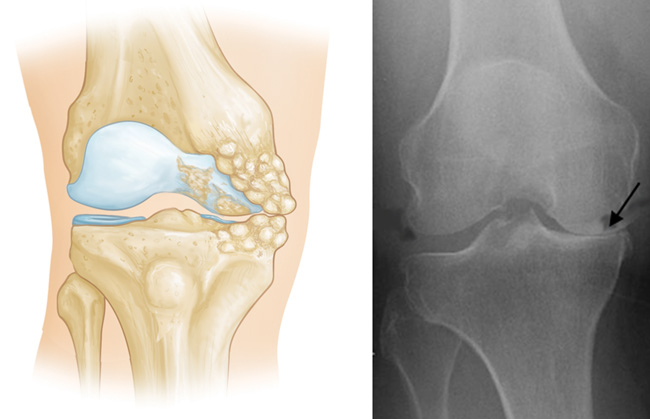
(Left) Osteoarthritis that is limited to the medial compartment. (Right) This x-ray shows severe osteoarthritis with “bone-on-bone” degeneration in the medial compartment (arrow).
Advantages of Partial Knee Replacement
Multiple studies show that a majority of patients who are appropriate candidates for the procedure have good results with unicompartmental knee replacement.
The advantages of partial knee replacement over total knee replacement include:
- Quicker recovery
- Less pain after surgery
- Less blood loss
Also, because the bone, cartilage, and ligaments in the healthy parts of the knee are kept, many patients report that a unicompartmental knee replacement feels more natural than a total knee replacement. A unicompartmental knee may also bend better.
Disadvantages of Partial Knee Replacement
The disadvantages of partial knee replacement compared with total knee replacement include:
- Slightly less predictable pain relief
- Potential need for more surgery. For example, a total knee replacement may be necessary in the future if arthritis develops in the parts of the knee that have not been replaced.
An advantage of partial knee replacement over total knee replacement is that healthy parts of the knee are preserved, which helps to maintain more “natural” function of the knee.
Candidates for Surgery
If your osteoarthritis has advanced and nonsurgical treatment options are no longer relieving your symptoms, your doctor may recommend knee replacement surgery.
In order to be a candidate for unicompartmental knee replacement, your arthritis must be limited to one compartment of your knee. In addition, if you have any of the following characteristics, you may not be eligible for the procedure:
- Inflammatory arthritis
- Significant knee stiffness
- Ligament damage
With proper patient selection, modern unicompartmental knee replacements have demonstrated excellent medium- and long-term results in both younger and older patients.
Orthopedic Evaluation
A thorough evaluation with Dr. Allsing will determine whether you are a good candidate for a partial knee replacement.
Medical History
We will ask you several questions about your general health, your knee pain, and your ability to function.
Location of pain. We will be specifically concerned with the location of your pain. If your pain is located almost entirely on either the inside portion or outside portion of your knee, then you may be a candidate for a partial knee replacement. If you have pain throughout your entire knee or pain in the front of your knee (under your kneecap) you may be better qualified for a total knee replacement.
Physical Examination
We will closely examine your knee. We will try to determine the location of your pain.
We will also test your knee for range of motion and ligament quality. If your knee is too stiff, or if the ligaments in your knee feel weak or torn, then we will probably not recommend unicompartmental knee replacement (although you still may be a great candidate for total knee replacement).
Imaging Tests
- X-rays. These images help to determine the extent of damage and deformity in your knee. Your doctor will order several x-rays of your knee to see the pattern of arthritis.
- Magnetic resonance imaging (MRI) scans. We may also order an MRI scan to better evaluate the cartilage.
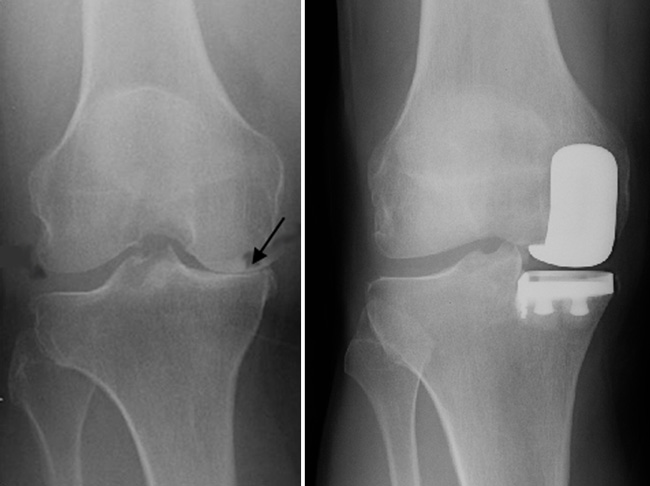
X-rays of a good candidate for partial knee replacement. (Left) Severe osteoarthritis limited to the medial compartment. (Right) The same knee after partial knee replacement.
Before Surgery
You will attend a Joint class and receive a CT scan which is a 3D X-ray. Using the CT scan, a 3D model of your knee will be created. This 3D model will be used to pre-plan and assist Dr. Allsing in performing your partial knee replacement.
Your Surgery
You will be admitted to the hospital on the day of surgery.
Before your procedure, a doctor from the anesthesia department will discuss anesthesia choices with you. We will also see you before surgery and sign your knee to verify the surgical site.
In the operating room, Dr. Allsing follows the personalized surgical plan while preparing the bone for the implant. The Mako system guides Dr. Allsing within the pre-defined area and helps prevent him from moving outside the planned boundaries. This helps to provide more accurate placement and alignment of your implant.
There are three basic steps in the procedure:
- Prepare the bone. Dr. Allsing will use the Mako robot to remove the cartilage from the damaged compartment of your knee.
- Position the metal implants. The removed cartilage and bone is replaced with metal coverings that recreate the surface of the joint. These metal parts are held to the bone with cement.
- Insert a spacer. A plastic insert is placed between the two metal components to create a smooth gliding surface.
Recovery room. After the surgery you will be taken to the recovery room, where you will be closely monitored by nurses as you recover from the anesthesia. You will then be taken to your hospital room.
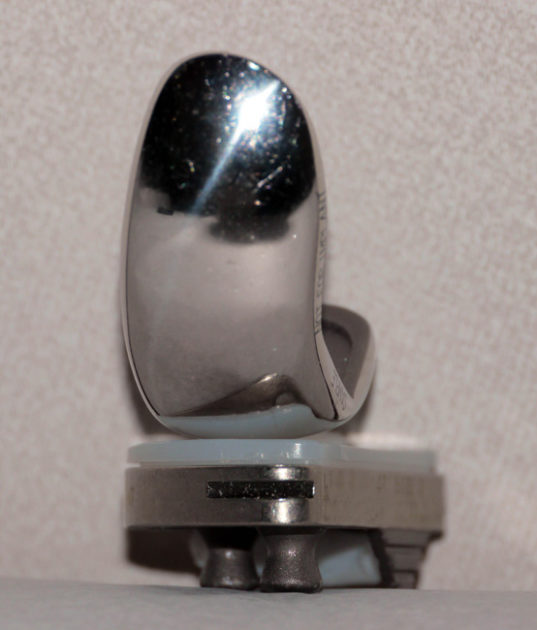
A partial knee replacement implant.
Complications
As with any surgical procedure, there are risks involved with partial knee replacement. Dr. Allsing will discuss each of the risks with you and will take specific measures to help avoid potential complications.
Although rare, the most common risks include:
- Blood clots. Blood clots in the leg veins are a common complication of knee replacement surgery. Blood clots can form in the deep veins of the legs or pelvis after surgery. Blood thinners such as warfarin (Coumadin), low-molecular-weight heparin, and aspirin can help prevent this problem. Newer blood thinners, such as apixaban (Eliquis) and rivaroxaban (Xarelto), may also be prescribed by Dr. Allsing, depending upon your needs.
Recovery
Partial knee replacement patients experience less postoperative pain, less swelling, and have easier rehabilitation than patients undergoing total knee replacement. In most cases, patients go home 1 day after the operation. Some patients go home the day of the surgery.
Pain management. After surgery, you will feel some pain, but we will make every effort to help you feel as comfortable as possible.
Many types of medicines are available to help control pain, including opioids, non-steroidal anti-inflammatory drugs (NSAIDs), and local anesthetics. Treating pain with medication can help you feel more comfortable, which will help your body heal and recover from surgery faster.
You will begin putting weight on your knee immediately after surgery. You may need a walker, cane, or crutches for the first several days or weeks until you become comfortable enough to walk without assistance.
A physical therapist will give you exercises to help maintain your range of motion and restore your strength.
You will continue to see us for follow-up visits in our clinic at regular intervals.
You will most likely resume all of your regular activities of daily living by 6 weeks after surgery.



